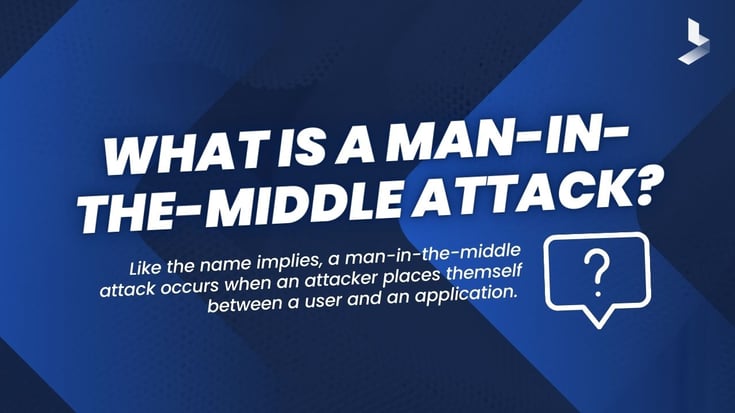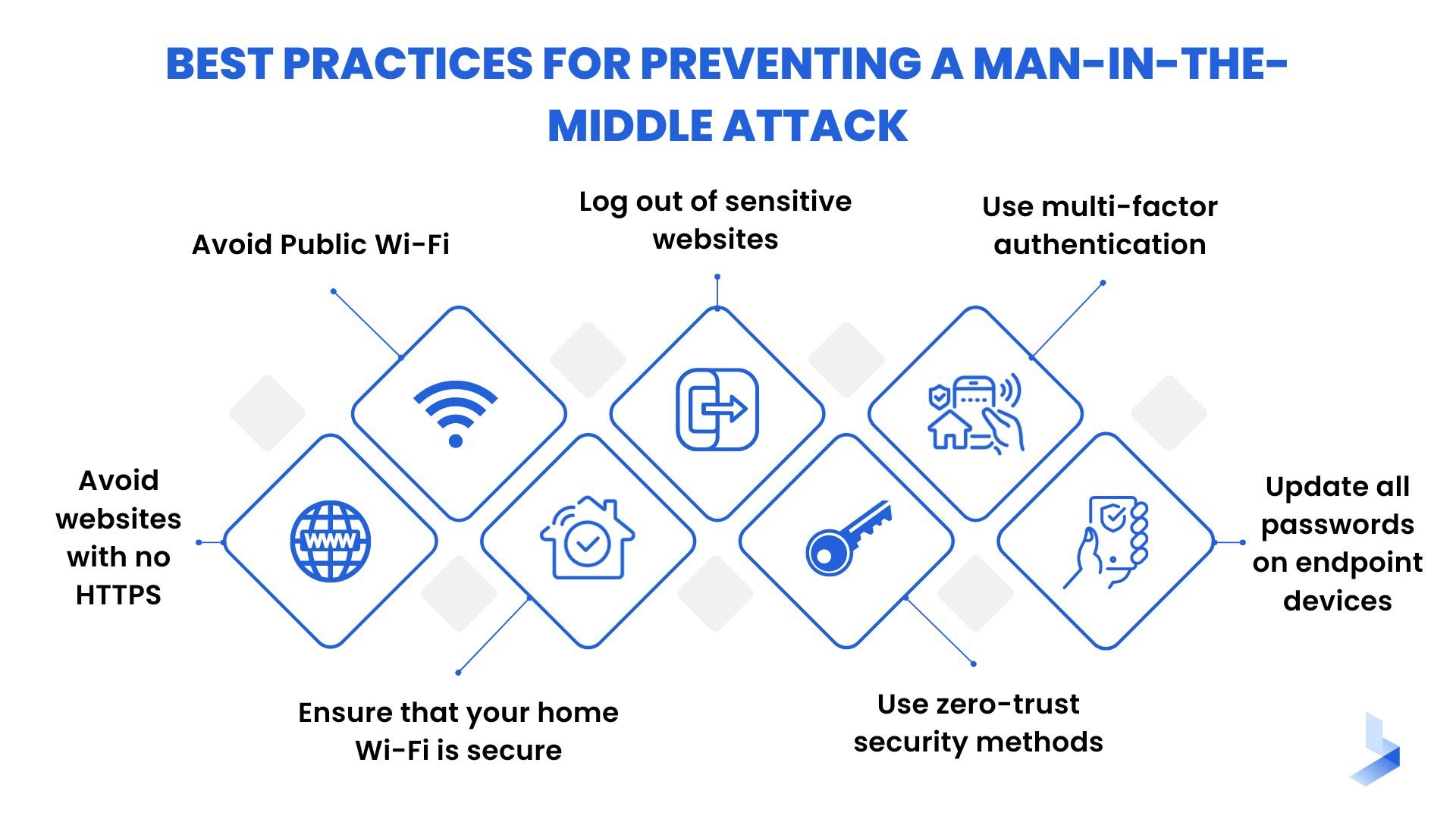Intercepted: The Hidden Threat of a Man in the Middle (MITM) Attack

 By
Emily Miller
·
8 minute read
By
Emily Miller
·
8 minute read
Cyberatttacks are a constant, ongoing source of concern for all types of businesses. Global cyberattacks increased by 38% in 2022. The increase in the U.S. was even more significant, at 57%. Yet, not all cyberattacks are the same, which means there is no way for businesses to apply a blanket approach to cybersecurity.
As businesses bolster their defenses against attacks, threat actors devise sneaky methods to work around common cybersecurity tools. Social engineering attacks prey on people instead of system vulnerabilities to steal sensitive data or gain access to a business network. A man in the middle attack is one of the most dangerous types of social engineering attacks. While these attacks aren't new, they're notoriously difficult to detect and can allow an attacker to modify data.
A man in the middle (MITM) attack interrupts legitimate communications to eavesdrop, interrupt, or change communications. Depending on the goal, the attacker can intercept browsing activity and redirect victims to malicious websites, capture financial information or login credentials, or alter communications in progress. Some MITM attacks don't even require the attacker to be on a trusted network. They only need a close enough physical proximity.
Man in the middle attacks feature an attacker who uses digital tools to get in between a user device or entity and their intended online destination. The growth of remote work and ever-increasing dependence on IoT devices is likely to provide attackers more opportunities to conduct MITM attacks. So, how can organizations continue to advance without falling victim to these covert attacks? By learning more about them and the tools and methods used to prevent them.
What is a Man in the Middle Attack?
Like the name implies, a man in the middle attack occurs when an attacker places themself between a user and an application. This type of attack may be used to discreetly gather information or to alter the communications of one or both parties. For example, if an attacker could successfully spoof your bank website, they could either use the information you shared to steal your credentials or change your instructions and transfer your funds to another account.
MITM attacks are carried out in two phases: interception and decryption. During the interception phase, the attacker intercepts your online activities before you reach your destination. This could mean redirecting you to a spoofed website or an unencrypted Wi-Fi connection where the attacker can observe all of your browsing activity. The decryption phase occurs when the attacker decodes stolen data and decrypts secure connections to remain undetected.
The goal of a MITM attack is usually to steal personal information like login credentials, account details, and credit card numbers. The information can then be used for identity theft, unapproved fund transfers, or a password change. These activities could have even more significant consequences within a corporate network.

How a MITM Attack is Carried Out
A MITM attack requires an attacker to intercept a user's web traffic. This is typically achieved with the exploitation of public Wi-Fi or through the installation of malware on the user's device. However, there are many techniques used to achieve different objectives.
- Wi-Fi Eavesdropping: The most common form of passive MITM attack, WI-Fi eavesdropping is a type of attack where attackers create Wi-Fi networks with common names to trick people into connecting with them. When you attempt to connect your device to public Wi-Fi, you may see the attacker's "Wi-Fi address" and allow the attacker to see all your online activities.
- IP Spoofing: Instead of interrupting your online communication at the connection level, IP spoofing alters the internet protocol (IP) address of a website, email address, or device, making the user think they're interacting with a trusted source. This type of attack is often used to interrupt enterprise communications or interrupt communication with a financial company.
- SSL Stripping: The use of HTTPS websites adds a layer of protection by encrypting all of the user's communications while they are interacting with the website. SSL stripping is a hacking technique where hackers remove the encryption and convert the website to HTTP. By downgrading the website, attackers can intercept network connections.
- Session Hijacking: More commonly known as browser cookie theft, an attacker steals information stored on web browser cookies (like saved passwords).
- Packet Injection: Data is sent across internet connections in the form of packets. When a hacker has access to network traffic, they can intercept these packets and replace them with malicious data. This allows the attacker to seamlessly blend malicious information with valid communication to make it appear more legitimate.
- ARP Cache Poisoning: Address resolution protocol (ARP) is the process that translates your computer's address to the IP Address on the local network. The process allows a local machine and gateway to recognize one another. When attackers have access to the network you're using, they can inject false information into the system to trick your computer into thinking the attacker's device is the network gateway. As a result, all of your network traffic passes through the attacker's device before reaching the internet.
By now you've probably realized that cybercriminals go to great lengths to carry out MITM attacks. After all, simply being connected to the same network as other devices doesn't provide you with access to the information transmitted from every device in your favorite coffee shop. Attackers use different tools to successfully carry out MITM attacks. Many of these tools are actually designed to improve security, but hackers use them to carry out attacks.
- Ettercap: A free, open-source tool, Ettercap is a packet capture tool used to write packets back into the network. The tool can be used to test the resistance of your system through attack simulations. It's often used for MITM attacks through ARP poisoning.
- Wi-Fi Pineapple: An auditing tool that allows cybersecurity specialists to test for vulnerabilities, a Wi-Fi Pineapple can also be used by attackers to interrupt communications between a user device and router to conduct MITM attacks.
- dSniff: Network traffic analysis tools to conduct penetration tests, dSniff can also be used to intercept communication between hosts.
- Evilginx2: A penetration testing tool, Evilgenx2 can be used to copy and steal cookies in a session hijacking attack.
- Sniffing Tools: Packet sniffers log network traffic on a network interface they have access to. While these tools can be used to diagnose network problems, hackers use them to extract passwords or other sensitive data.
2 Types of Man in the Middle Attacks
While MITM attacks may be carried out in several different ways, there are two main types of man in the middle attacks.
- Passive man in the middle attacks: A passive attack is basically a high-tech form of eavesdropping. The attacker intercepts your correspondence to quietly observe data transmitted across the network. If useful information is gleaned during the eavesdropping session, it can be used to launch a future attack. For example, an attacker creates a free malicious WiFi hotspot cleverly named to correspond with their location and gains full visibility to any online data exchange of devices that connect to the hotspot.
- Active man in the middle attacks: An active attack is one where the attacker intercepts communications and modifies them for malicious purposes. In an active attack, the attacker may alter IP addresses of intended destinations or redirect your computer to connect to the attacker's device rather than your router when you attempt to go online. For example, an attacker creates a fake website with a spoofed DNS. When the target enters login credentials, the attacker can use those credentials on the legitimate site to gain access.
Consequences of a Man in the Middle Attack
Both consumers and businesses can fall victim to MITM attacks. Since the method can be used in such a wide range of situations, the consequences of these attacks can vary considerably. MITM attacks are often used to intercept sensitive information like usernames, passwords, credit card numbers, and bank account details. When these details are used to target an individual, the victim might be charged for products or services they didn't purchase. When the attack is launched on a business, credential theft through a MITM attack can act as an initial gateway to an advanced persistent threat (APT) that affects multiple points of the business network.
Depending on the goal of the attacker, the consequences of MITM attacks usually fall into one of three categories.
- Financial: MITM attacks are often used to target communications with financial institutions. Once an attacker has access to account credentials, they can steal funds, make transfers, or make unauthorized purchases while appearing legitimate.
- Personal: Any MITM attack places a threat actor in the middle of a communication stream intended to be private. A passive eavesdropping attack can cause significant personal damage to an individual if it's used for identity theft. An active attack in which the attacker modifies communications can convince others that the victim is taking actions they aren't actually responsible for.
- Professional: A MITM attack that targets a business can have catastrophic and far-reaching professional consequences. When an attacker can move within a network appearing as a legitimate user, they can potentially download malware, gain access to sensitive business data, infect the end product of a SaaS provider, etc. Depending on the activities of the attack, the business may face significant reputational damage as well as financial damage.
Prevention and Protection Against Man in the Middle Attacks
MITM attacks are different from other social engineering attacks in that they often work to trick the device instead of the user. As a result, the attacks can be more difficult to detect and cause more damage in a short period of time. Yet, by taking preventative action, you can make your online activities less vulnerable to MITM attacks.

Best Practices for Preventing a Man in the Middle Attack
- Avoid using public Wi-Fi for transactions that require your personal information. If you must use public Wi-Fi, use a VPN to ensure your data is always encrypted.
- Log out of sensitive websites as soon as you're finished to avoid session hijacking.
- Use multi-factor authentication (MFA) whenever possible to add an extra layer of security to all accounts. It could limit an attacker's accessibility if they successfully steal your password.
- Avoid websites with no HTTPS connection.
- Ensure that your home Wi-Fi is secure by updating all default usernames and passwords on your home router and connected devices.
- Secure your business network by using zero-trust security methods and network segmentation.
- Update all passwords on endpoint devices.
Tools and Software
- Ransomware Detection Software: Ransomware detection software like a SIEM system logs traffic across an entire network. This is particularly helpful in avoiding MITM attacks that use malware to target a business network. When AI features are included in the software, the system can detect early signs of a potential attack, recognize known malware, and quarantine affected devices.
- Tools used in Penetration Testing: We noted that many of the tools used by attackers perpetrating a MITM attack are designed to check for vulnerabilities. The use of these tools by a cybersecurity expert during penetration testing can help you learn how your network is vulnerable to MITM attacks.
- Endpoint Security: IoT devices and remote devices are some of the most vulnerable to MITM attacks. Strong endpoint security software can automatically recognize and quarantine threats.
- Network Traffic Analysis Tools: MITM attacks usually feature an attacker masquerading as a legitimate user. Network traffic analysis logs all network traffic to define behavior that is common to specific users and entities. Alerts that identify suspicious behavior can allow you to halt an attack in progress.
Steps to Take if you Suspect You're a Victim of a Man in the Middle Attack
If you suspect you're the victim of a MITM attack, it's important to act quickly. By taking quick protective measures, you may be able to halt the attack in progress.
- Terminate your internet connection.
- Access the internet through a secure connection and change your passwords, usernames, and logins.
- If your communications with a third party (like your bank) were interrupted, contact them to inquire about activity and determine next steps to further protect your account from potential damage.
- Run vulnerability scans to ensure your network is no longer compromised.
Preventing the Consequences of a MITM Attack with Multi-Layered Security
MITM attacks aren't new. They're not even the easiest form of attack for cybercriminals to carry out. Yet, as long as they provide attackers with access to sensitive data, they're not likely to stop occurring. Increased dependence on IoT devices and the growth of remote work could even result in an increase in these types of attacks as lower levels of security in these devices provide more opportunities for attack.
Man in the middle attacks prey on a user's dependence on their device to follow the right channels and lax security measures. When an attacker manages to position themself in between two parties, they can steal or modify communications in one of the most discreet ways possible. In a business network, the result could be catastrophic.
It's always important to educate yourself and your employees about best practices to avoid cyberattacks. However, MITM attacks can be challenging to detect and can cause extensive damage. A multi-layered approach to security heightens your ability to stop an attack with the ability to detect and stop attacks from different points in the network. Instead of depending on a single indicator of compromise, your system can defend against the many different actions that are likely to indicate a MITM attack. If you're unsure whether your network is vulnerable to MITM attacks, BitLyft can help. Contact us to learn more about these and other social engineering attacks and how you can keep your business network safe.
Download a Free Incident Postmortem Template

